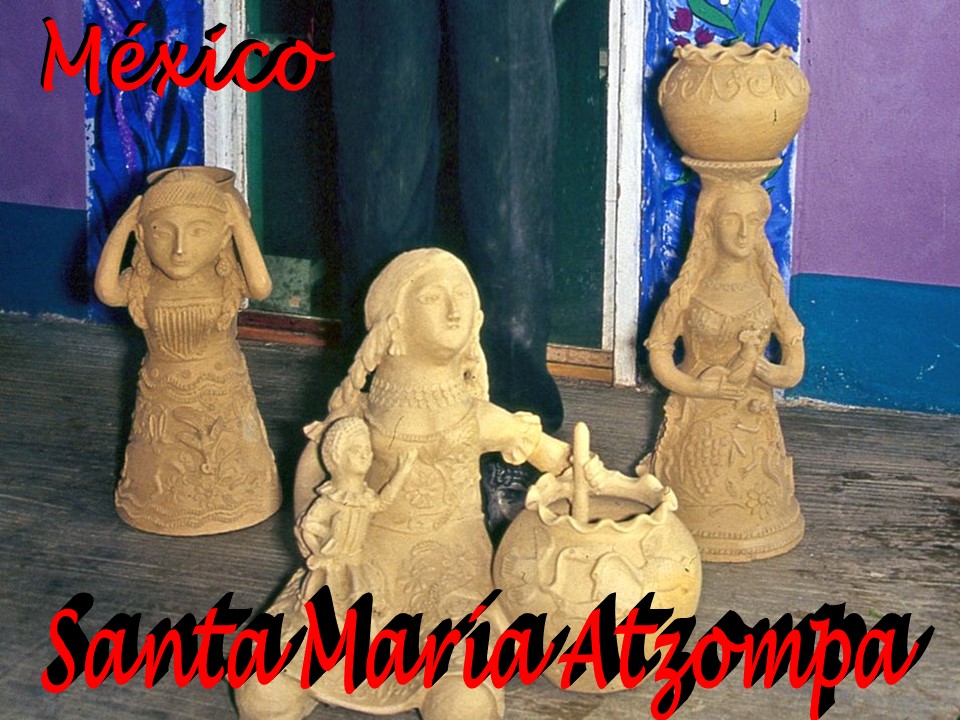Mexico Santa Maria Atzompa - PowerPoint PPT Presentation
Title:
Mexico Santa Maria Atzompa
Description:
The most prevalent of Mexico’s crafts is ceramics/pottery. Ceramics was considered one of the highest art forms during the Aztec Empire, with the knowledge of making pottery said to have come from the god Quetzalcoatl himself – PowerPoint PPT presentation
Number of Views:3
Title: Mexico Santa Maria Atzompa
1
México
Santa María Atzompa
2
Ceramic in Monte Albán Museum
3
Zapotec ceramic on display at the Monte Albán
Museum The most prevalent of Mexicos crafts is
ceramics/pottery. Ceramics was considered one of
the highest art forms during the Aztec Empire,
with the knowledge of making pottery said to have
come from the god Quetzalcoatl himself.
4
Zapotec statue from the site museum at
Monte Albán
5
Zapotec statue from the site museum at
Monte Albán
6
the National Museum of Anthropology in Mexico
City The plaited headdress on this Zapotec statue
looks like that worn by women in Oaxacan
villages today.
the National Museum of Anthropology in Mexico
City One of the many beautiful pieces of
Zapotec pottery
The Monte Albán archeological site, found in the
southern Mexican state of Oaxaca, was one of the
first cities in Mesoamerica, and functioned as
the center of Zapotec culture for over a thousand
years. Founded around the year 500 BC, it reached
its zenith by the 3rd century AD before
eventually collapsing by the 8th century AD.
7
(No Transcript)
8
The town Santa María Atzompa is located a few
kilometers from the archaeological site of Monte
Albán. Pottery-making has always been an
important activity in Santa María Atzompa since
it was founded between the 7th and 9th centuries
just north of the Zapotec city of Monte
Albán. The name Atzompa means high water mark in
the Nahuatl language.
9
While almost all of Atzompas pottery is of the
traditional green-glazed variety, since the
1980s, a potter by the name of Dolores Porras has
created the first glazed natural color and
multicolored glazed pottery.
10
Dolores Porras developed a white translucent
glaze on which to paint colors such as bright
oranges, blues, greens and yellows. Each of her
pieces are done by hand and are decorated with
figures such as borders, mermaids, flowers and
iguanas. She has been invited to give workshops
in the United States, where she learned about
lead-free glazes and has applied these to her
work.
11
(No Transcript)
12
(No Transcript)
13
(No Transcript)
14
Recently, several innovations have been devised
to try and help revive the pottery market. In the
1990s, the Mexican government developed lead-free
glazes to be mass marketed. In the 2000s, a
cooperative pottery market was created in the
town, and the efforts of potter Dolores Porra,
who created new designs and colors, has been
recognized.
15
(No Transcript)
16
(No Transcript)
17
(No Transcript)
18
A number of potters in Atzompa have turned to the
making of clay figures, terra cotta figurines
called "embroidered dolls" (muñecas bordadas) who
are made with long skirts that reach the floor,
(eliminating the need to create breakable feet)
elegantly adorned with earrings, necklaces and
their dresses are decorated with elaborate floral
designs.
19
There are also mermaids and angels. Each piece
is unique and the colors are produced by mineral
pigments in local rocks.
20
Despite being close to the city of Oaxaca,
Atzompa is a very poor community which subsists
mostly on the production of its signature green
pottery.
21
The town is attracting an increasing number of
Mexican and international tourists because of its
pottery, which is helping the towns economy. The
new crafts market has done much to attract these
tourists.
22
The new crafts market has done much to attract
these tourists. The market is not only a central
location for the sale of the pottery, it is also
set up to allow communal selling of the products
and allow the artisans to spend less time selling
and more time making pottery.
23
The pieces are labeled as to the artisan and the
artisans rotate shifts at the market.
24
(No Transcript)
25
(No Transcript)
26
Angelica Vazquez Cruz, an unusual potter in a
village of trade potters, for what she makes is
expressive and comes from he internal vision,
making her more akin to our western view of an
artist
27
Angelica Vazquez Cruz
28
Angelica Vazquez Cruz
29
Angelica Vazquez Cruz
30
Angelica Vazquez Cruz
31
Angelica Vazquez Cruz
32
Angelica Vazquez Cruz
33
Angélica's creations encompass a wide spectrum
small ethereal but spirited angels, to majestic
female figures and large sculptural compositions.
Due to their complexity and detail, the latter
can take up to four weeks to create. She refers
to such pieces as "temas completas" (complete
themes), in that they convey her interpretations
of historical and contemporary subjects, such as
the Mexican Revolution or the Abastos market
(usually the largest market in a town). Although
her artistic expression is achieved through old
folk arts techniques, her themes can often be
considered "modern. mermaids and angels. Each
piece is unique and the colors are produced by
mineral pigments in local rocks.
34
Angelica Vazquez Cruz
35
Angelica Vazquez Cruz
36
Angelica Vazquez Cruz
37
Angelica Vazquez Cruz
38
Angelica Vazquez Cruz
39
Angelica Vazquez Cruz
40
Duelo by Angelica Vasquez Cruz of Santa Maria
Atzompa at Museo Estatal de Arte Popular1 de
Oaxaca in San Bartolo Coyotepec, Oaxaca
41
Angelica Vazquez Cruz
42
México
Text pictures Internet Copyright All the
images belong to their authors Presentation
Sanda Foisoreanu
2012
Sound Lila Downs - El Feo, Cancion Mixteca,
Arrancame la Vida































